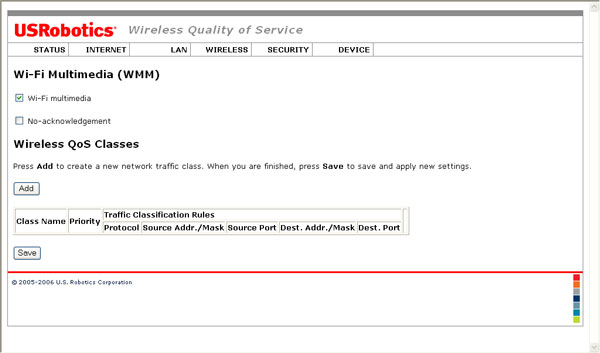
Note: Wireless transmission must be enabled to access Wi-Fi Multimedia (WMM) or Wireless Quality of Service options.

The router is set to enable Wi-Fi Multimedia by default. This feature enables the Quality of Service (QoS) function that is used for multimedia applications, such as Voice-over-IP (VoIP) and video. This allows the network packets of the multimedia application to have priority over regular data network packets, allowing multimedia applications to run smoother and with fewer errors.
All WMM devices that connect to the router must also have WMM enabled to use this feature.
With WMM enabled, you can select Enable no-acknowledgement. No-Acknowledgement refers to the acknowledge policy used at the MAC level. Enabling no-acknowledgement can result in more efficient throughput but higher error rates in a noisy Radio Frequency (RF) environment.
To disable WMM, deselect Wi-Fi Multimedia. If you had Enable no-acknowledgement selected, it will also be disabled.
The Quality of Service feature is useful when some of the traffic handled by the router has higher importance than other data being handled at the same time. For example, you might set up your computer to make telephone calls over the Internet. If you have a voice conversation while your computer is also downloading a file, you would want the voice conversation to take precedence over the file download, since delays in transmitting voice messages would cause signal dropouts and poor sound quality.
The QoS feature would help you if all of the following conditions are met:
QoS classifies traffic according to classification rules you define. Each rule may contain a combination of the following conditions: protocol (TCP/UDP/ICMP), source IP address/subnet mask, destination IP address/subnet mask, source port (one or range), destination port (one or range). Any session that matches a classification rule receives a certain priority (high, medium, low) and a type of service (normal service, minimum cost, maximum reliability, maximum throughput, or minimum delay).
The priority of the matching rule determines which ATM TX queue to send over the PVC if the packet is routed to this PVC. ATM picks packets to process according to these priorities:
QoS only works for QoS-enabled PVCs. If data is routed to a regular QoS-disabled PVC, it will receive the same priority level as the low priority of a QoS-enabled PVC in the same ATM service category.
To enable the QoS feature, follow this procedure:
Return to the Wireless menu options.